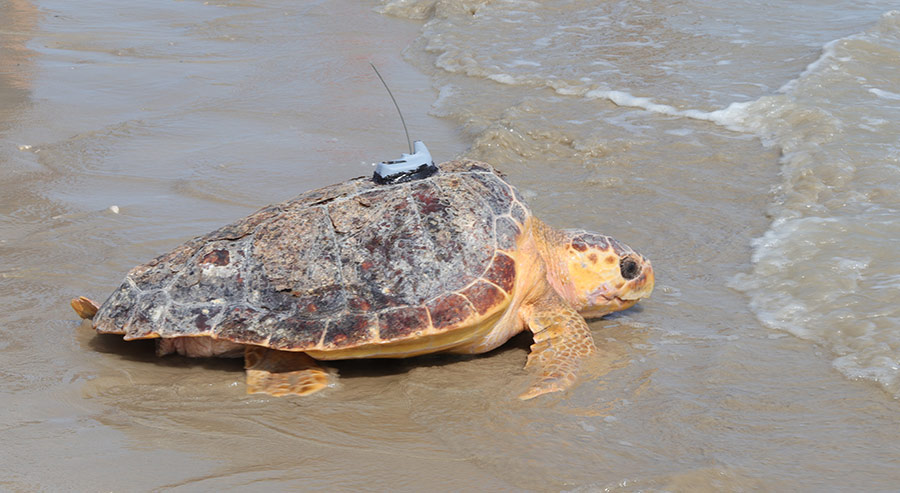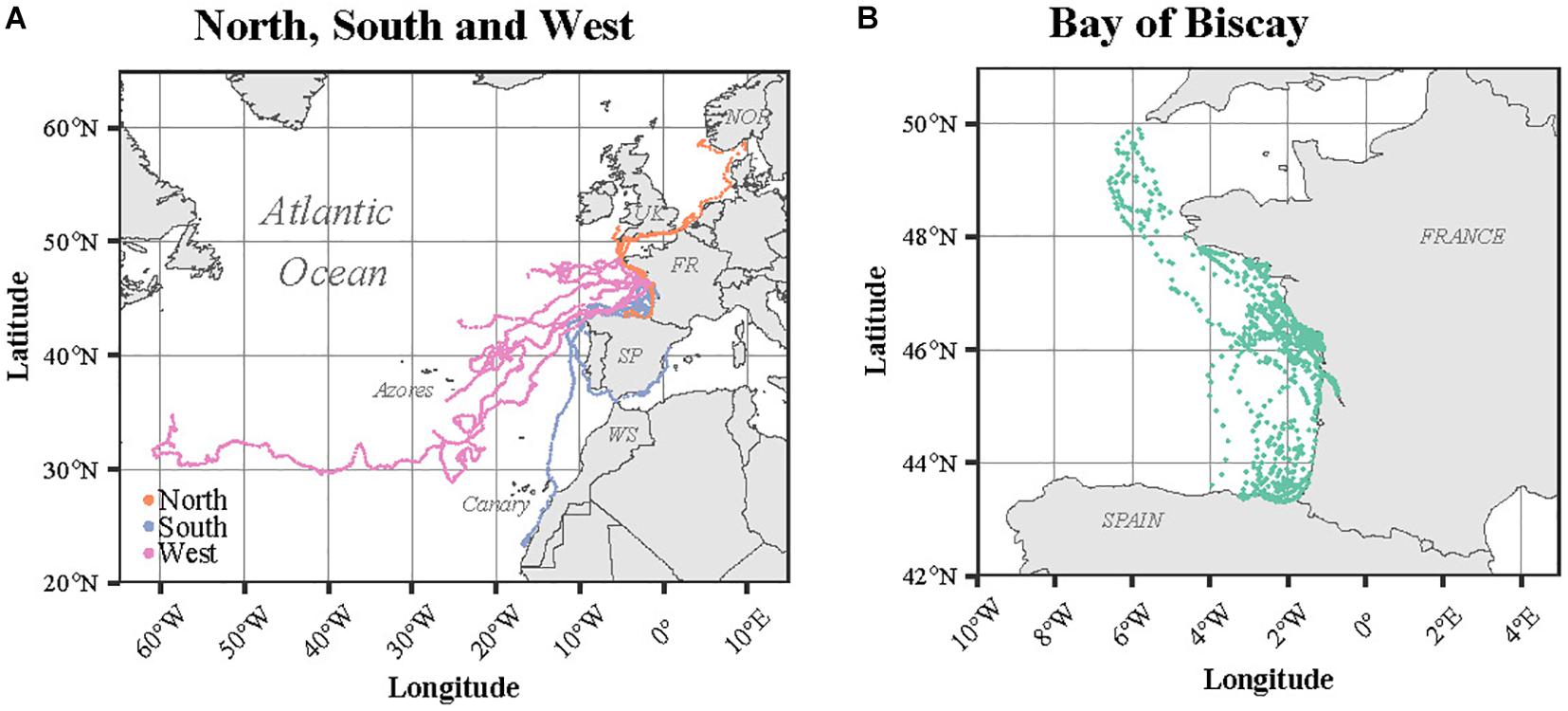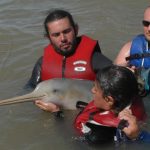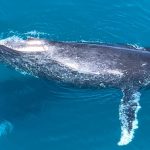← Back
Turtles in the Bay of Biscay

Juvenile sea turtles are cared and rehabilitated at Aquarium La Rochelle, in France. Since 2008, a few of them were equipped with Argos PTTs before being released. Analysis of their tracks could help understand if they were trapped in a nutrient-rich but cold in winter Bay of Biscay, or if that area fits their needs.
Photo: a loggerhead turtle at release with an Argos PTT ((c)Océane Cottier_Aquarium La Rochelle SAS)
Sea turtles could be also observed in the Mediterranean and the North-East Atlantic european waters. However, in winter, these waters can be cold for turtles and they can then suffer from cold-stunning. Immature loggerheads, greens and Kemp’s ridleys are nonetheless observed there. The question is if this area could be a favorable habitat or if it is rather a “trap” where immature sea turtles go at favorable times and can’t get out when it gets colder in winter.
Between 2008 and 2020, 66 immature sea turtles have been reported, mainly during the winter months, then cared and rehabilitated by the CESTM (Centre d’Études et de Soins pour les Tortues Marines) of the Aquarium La Rochelle, France, on the coast of the Bay of Biscay. Among these, 28 were then equipped with Argos satellite transmitters and released close-by.
A majority of them were loggerhead turtles (23 individuals), but four were also Kemp’s ridley and one green sea turtle. We already mentioned three of them (see Understanding the tracking of three loggerhead turtles with ocean data and Two very different destinations for two adventurous turtles). All were rescued along the French Atlantic coasts, either found stranded (17 individuals), bycaught (8) or drifting at sea (3). Moreover, 33 years of sightings (1988–2020) for CESTM including a total of 449 sightings of immature sea turtles were used to assess even better their habitat use of the Bay of Biscay.
More info about animal tracking with Argos
Rehabilitated sea turtle tracking analysis
Four main directions for all the tracked turtles have been identified: Bay of Biscay, North, South and West, according to the last position recorded for each individual. The “Bay of Biscay” pattern refers to potentially resident turtles (11 individuals, 41%) remaining within the area. “North” refer to the turtles which went North (three individuals), and similar for South (three individuals also, heading toward Portugal, the Mediterranean Sea and Western Sahara) and West (10). The West group migrated westward/southwestwards in the open Atlantic Ocean, possibly towards their natal beaches. Their tracking was lost around the Azores, Canary or even Bermuda Islands.
Comparisons with environmental oceanic data were done. Swimming speed of each individual was calculated by subtracting modeled ocean current velocity from the speed obtained from the positions. For all the tracked turtles, there were differences in the directions and speeds compared to ocean currents, showing they are indeed actively moving and have strength to do so in other directions than the current. Temperature and prey biomass outputs were also compared with the positions and used in a habitat model. The smallest individuals seem to exploit colder waters than the largest individuals. Nearly half of the locations recorded were associated with waters between 15 and 20°C, and only 18% below 15°C.

Satellite tracks of the immature turtles according to the pattern of their travel: (A, left) North (3 turtles), South (3) and West (10) and (B, right) Bay of Biscay (11 turtles). (from [Chambault et al., 2021])
One loggerhead turtle reached Bermuda Islands where the tag stopped emitting. These islands could be a stopover before reaching the nesting beach in Florida or a permanent foraging ground.
Three turtles headed northwards in critically unsuitable habitats (SST below 8°C). Two among those were Kemp’s ridley turtles. The reason for their travel north is unclear – disorientation, unusually productive and/or warm waters masses leading the turtles to go further north than they would normally have, …
The Bay of Biscay, probably a real habitat, even if a risky one
The Bay of Biscay might act as an ecological trap for the smallest individuals but also as a potential foraging habitat in summer and autumn but with low sea temperatures in winter. Their swimming speeds analysis excludes the hypothesis that the turtles remained in their habitats due to ocean currents transport after release. It rather suggests a real habitat use at least during summer and autumn. However, all the rescued turtles were in distress when found which suggests the reason of their arrival in such area might be related to unsuitable conditions prior their rescue.
The number of rescued individuals per year is relatively low. It is thus hard to estimate the real proportion of immature sea turtles inhabiting the European waters, and among them the proportion which might suffer from cold-stunning in winter.
Sea turtles face many other threats at sea such as marine debris (entanglement or ingestion), organic pollutants, or the entanglement and accidental bycatch in fishing gears.
Reference & links
- Chambault P, Gaspar P and Dell’Amico F (2021) Ecological Trap or Favorable Habitat? First Evidence That Immature Sea Turtles May Survive at Their Range-Limits in the North-East Atlantic. Front. Mar. Sci. 8:736604. doi: 10.3389/fmars.2021.736604 https://doi.org/10.3389/fmars.2021.736604
- CESTM (Centre d’Études et de Soins pour les Tortues Marines): https://www.aquarium-larochelle.com/en/preserve/study-and-care-centre-for-marine-turtles/
- Facebook : https://www.facebook.com/Aquarium-La-Rochelle-113545370087887
- Twitter: @PhilippineCham1
- https://twitter.com/aqualarochelle


